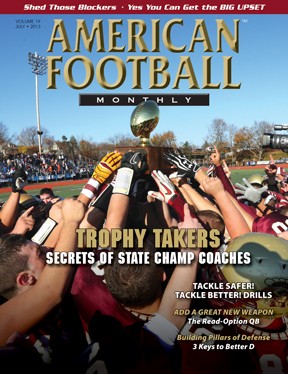Article CategoriesAFM Magazine
|
New Weapon More and more offenses are adding a read-option scheme to incorporate the QB into the running game.by: Eric LongOffensive Coordinator, St. Francis University (PA) © More from this issue In this new age of football, teams are using athletic quarterbacks to add an additional dimension to their offense. I believe the pro-style attack offenses will mirror this trend, whether its a specific package or a main part of their offense. We began this transformation this past year. Last fall, we had a very athletic quarterback that we wanted to utilize in our run game. After implementing this, we ended the season ranked 12th nationally within FCS in rushing and our QB ran for 918 yards. By adding the QB to our running attack, we were able to find the edge that allowed our offense to be successful. With the success of QBs like Robert Griffin III and Colin Kaepernick, many programs feel the need to implement a read-option scheme and incorporate the QB into the run game. However, I beli....The full article can only be seen by subscribers.
|
|
|||||||
| HOME |
MAGAZINE |
SUBSCRIBE | ONLINE COLUMNISTS | COACHING VIDEOS |
Copyright 2025, AmericanFootballMonthly.com
All Rights Reserved





